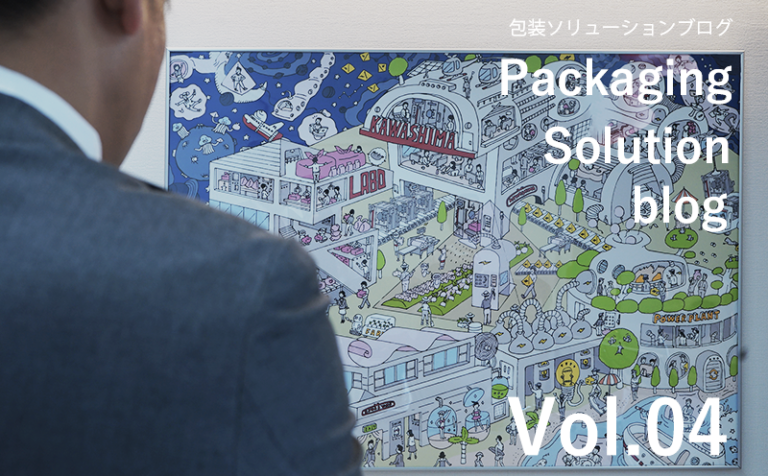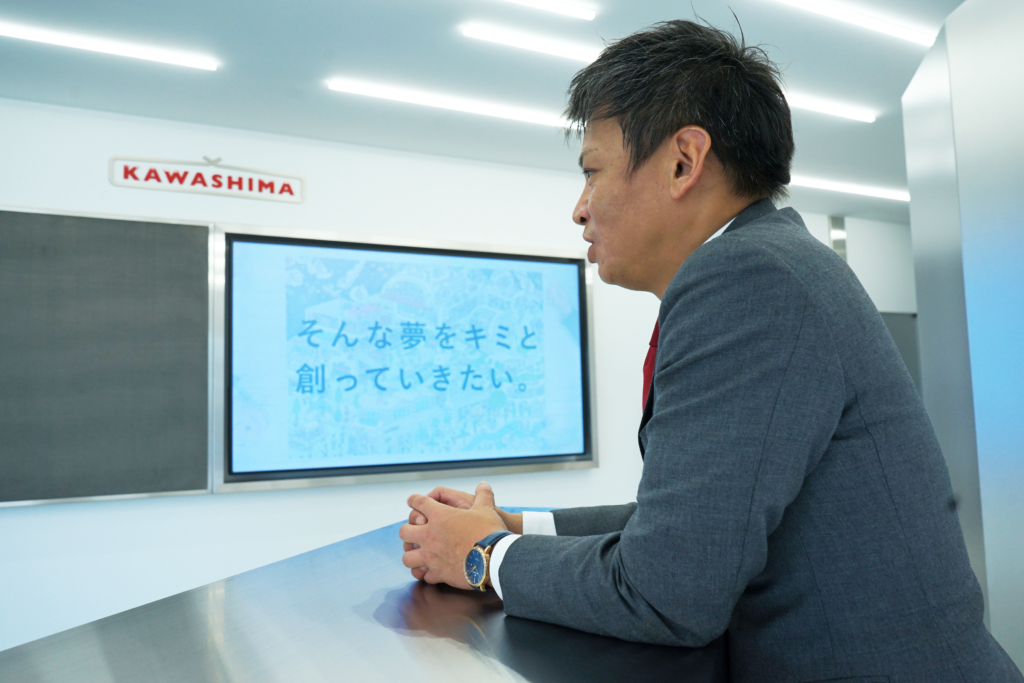
The future of packaging technology that will change manufacturing – This is how your future will change!
-
- Category:
- COLUMN
-
- Date:
- May.8.2024
Interview with Kenkichi Abe, General manager, Solution Strategy Department at Kawashima Packaging Machinery Ltd.
Measures for SDGs/carbon neutrality and the future led by the latest environmental technology
Changes in consumer awareness and the market environment are now spreading across the world as a major trend. Environmental awareness has grown rapidly over the past few years, resulting in SDGs as the fruition. Corporate management is under great pressure from the external factors, such as rising energy costs and a competitive environment that makes it difficult to differentiate. How can we continue to grow sustainably in this era of dramatic change? Kenkichi Abe, head of the Packaging Solutions Strategy Office, will talk about the response of Kawashima Packaging Machinery Ltd. to SDGs and carbon neutrality, the progress of the latest environmental technology, and the innovative packaging technology that will lead the future and solve the challenges faced by food manufacturing sites.

The future of packaging technology that will change manufacturing ~ This is how your future will change!
What does Kawashima think of future packaging machines?
>So far, we have asked about initiatives of Kawashima Packaging Machinery Ltd. for SDGs and the latest technology of their packaging machines. In this final episode, I would like to ask you about future packaging machines and future technologies. First of all, what do you think will be required of packaging machines in the future?
Abe: I feel that what will be required in the future is the ability to respond to labor-saving and unmanned factories. A survey* conducted around November last year revealed that there is a tendency for managers to be increasingly concerned about labor shortage. In fact, in a survey conducted in 2019, before the coronavirus, nearly half of companies cited “labor shortage” as a risk that could have a negative impact on the economy. However, in 2020, due to a sudden reduction in the amount of work caused by the coronavirus pandemic, people were more concerned about the spread of the infectious disease and the deterioration of employment conditions than labor shortage. It was only last year that the society’s concern changed. With the recovery of business, labor shortage was once again being concerned. In fact, as of December 2021, the labor shortage rate for companies was 47.5% for regular employees and 27.7% for non-regular employees. It has already returned to levels close to pre-coronavirus levels in 2019.
Abe: That’s right. The economy is recovering and jobs are increasing, but there are no workers. I think this is due to a wave of declining birthrate and aging population. Especially for manufacturing industries related to food, there is a serious shortage of people. Even if we try to improve this problem by offering part-time jobs and higher hourly wages than in the past, it is still difficult to attract people. Even though before the coronavirus, there was also a serious labor shortage, but I feel that foreign workers were able to compensate for the shortage. However, due to the coronavirus pandemic, travelling to and from overseas has been restricted, and the number of foreign workers has decreased dramatically. The economy is on a recovery trend, but the coronavirus pandemic seems to be accelerating the labor shortage. In addition, considering the risk of cluster infections caused by the coronavirus, it is essential to improve machinery so that fewer people are enough to work comfortably.
>If unmanned factories can be realized, telework in the manufacturing department will likely become a reality.
Abe: I sometimes hear people say that “telework is difficult for the manufacturing department because you have to be on site to do your job,” but I don’t think that’s the case. Of course, until now, you couldn’t work without going to a factory. This is because people in the manufacturing department have traditionally performed tasks that are integrated into the production line, such as measuring raw materials and putting them into machines, and putting strawberries on cakes. But now, technology is advancing dramatically. By incorporating AI into machines or using robots, human hands are freed from simple tasks that have been traditionally done by humans but can now be done by machines. When that happens, people will only need to give instructions on what to make and how much to make, and supervise the machines to make sure they are working properly. If the machines are connected to the network, there is no need to be in the factory. In other words, jobs in the manufacturing department that were previously thought to be impossible to do remotely can now be done remotely.
>It seems likely that maintenance (maintenance/inspection) to check for any defects will be able to be performed remotely.
Abe: Up until now, we had to go to the location where the machine was located to perform maintenance. If it can be maintained remotely, it will be possible to operate the machine remotely except when adjusting or repairing it on-site. Particularly during regular inspections, there are often no abnormalities, so it saves the trouble of going to the factory each time, and that time can be used for other things. Business efficiency can be greatly improved.

*1 Survey of corporate attitudes toward the economic outlook for 2022 / Source: Teikoku Databank [Reference]
https://www.tdb-di.com/2021/12/sp20211214.pdf
Increasing needs for prevention and prediction
>I have heard that for a packaging machine, maintenance after installation is very important.
Abe: What a manufacturing factory should never do is to stop the production line. What would happen if the packaging machine suddenly stopped working during operation? The product cannot be packaged or shipped. If a product is out of stock, it will cause trouble in many ways. What we need to think about maintenance from now on is preventing problems from occurring while machines are in operation. In other words, preventive and predictive maintenance can detect problems before they occur.
>If you know in advance that a problem will occur, you can avoid situations where the machine suddenly breaks and the line stops.
Abe: As long as it is a machine, it is inevitable that it will malfunction or break if used continuously. Up until now, we have responded to questions on phone calls, or situations like “please come over for a moment”. However, in such cases, production would stop until the machinery was repaired. If there was a function that could tell you that a machine is about to break before it stops working, it should be possible to take measures such as making repairs during holidays or replacing parts that are likely to malfunction in advance.
> By doing so, you can prevent the line from stopping. What is the difference between “preventive maintenance” and “predictive maintenance”?
Abe: Simply stated, preventive maintenance means informing the expiration date of a product in advance and sending an alert when the expiration date approaches. For example, when you buy a new computer, the warranty period will be shown in advance. However, unless it’s a special anniversary, few people remember the exact date of the purchase. So, for example, if the warranty period is two years, as the expiration date approaches, a text message will be displayed on the monitor that says, “It has been used for almost two years, so please consider purchasing a new product.” This is preventive maintenance. On the other hand, predictive maintenance looks at the condition of machinery regardless of its age. Using the previous example, even if a product is made to last for two years, depending on how it is used, problems may occur within a few months. On the contrary, there are cases where no problem occurs even after three or five years. With predictive maintenance, you can check the usage status and current condition of the machine and receive notifications before it breaks, such as “It has been used frequently and is about to wear out, so please replace it,” or “It is heavily worn and can only be used a few more times.”
>Preventive maintenance is already being implemented in some areas.
Abe: Currently, we don’t have much data, so we can only simply display expiration dates, but in the future we plan to collect a variety of data and compile statistics to improve the accuracy of preventive maintenance. The more data you have, the more clearly you can see the likely relationship between how you use the machine and when it breaks down. We are also currently considering how to incorporate predictive maintenance into production lines in the future.
>I have heard that there is still no packaging machine in the industry that has the function of predictive maintenance.
Abe: In the case of packaging machines, they are often customized to suit individual conditions, so I have not yet heard about any company that can produce packaging machines with predictive maintenance functions. We are also thinking about how to incorporate predictive maintenance into our machines.
Recently, customers have been asking us, “Isn’t AI included in packaging machines?” It has become commonplace for home appliances, automobiles, etc. to already incorporate AI. Even with packaging machines, it seems possible to check the level of abrasion on the machine by making good use of AI and cameras. We are considering methods to achieve that with new packaging machines.
>It seems like there will be a future where machines will be regularly diagnosed by AI, just like we do physical examinations.
Abe: I think predictive maintenance will definitely be necessary in order to avoid pauses of the production line. I think it is necessary to consider how AI can be incorporated and utilized for predictive maintenance.
Creating work styles that make life more enjoyable
>I’ve heard that when assembling, setting and adjusting machines on site, there are big differences in the skill level of individual engineers.
Abe: It is true that even if machines are adjusted in the same way, the operating rate can vary greatly depending on the person who performed the adjustment. In the future, I think it will be important to standardize the process so that everyone can get the same results. Additionally, there are times when parts of some machines need to be replaced, and currently these replacement parts can weigh more than 15 kilograms. If it’s that heavy, only a strong person can replace it. I think we need to consider redesigning the packaging machine itself so that there are no tasks that only a specific person can do.
>Everyone can use it in the same way and anyone can easily maintain it. Perhaps there will be a demand for such a machine.
Abe: As our company’s president often says, we want to create a packaging machine that is not for particular people, or that doesn’t rely on people. I believe that packaging machines which “help people” will be needed in the future.
>Regarding packaging machines which “help people”, Kawashima is already working on improving its operability.
Abe: The control panel was designed to be understood at a glance. A chat Q&A service is also available on the website, where you can get answers in an interactive manner.
>So, what does Mr. Abe think is the “ultimate packaging machine”?
Abe: It’s a packaging machine that automatically moves and wraps when you just say “Wrap it”. A packaging machine that does not require human hands. Once this is created, it will be possible to make factories unmanned. Nowadays, most companies have large numbers of people working in factories, and many jobs are carried out by hand. However, if we can relegate such simple tasks to machines, I think people will be able to focus on more creative and high-value-added work.
>By putting this into practice, I think in the future, regardless of nationality or gender, people with powerful or weak strength can work equally and creatively.
Abe: Changing the packaging machines will change the way we work in the factory. If the way of working changes, the way of thinking of the people working there will also change. The change will spread to other areas, and the mindset of “working” in the food industry as a whole will change. You should be able to work in a better way and create higher added value. We have also received inquiries from several companies about traceability of the product, such as where the packaged products are now, who bought them, and in what region are they consumed. It is possible to trace the product to some extent by assigning a unique number to the bag. By attaching tags that can capture more detailed data, it will be possible to predict what kind of products should be released and when and where to sell them. In the future, we would like to go beyond simply improving packaging machines and propose ways to solve various issues through packaging, such as traceability through packaging. Kawashima Packaging Machinery Ltd. is committed to expanding the possibilities of packaging and delivering an exciting future to everyone.

(Fin.)




